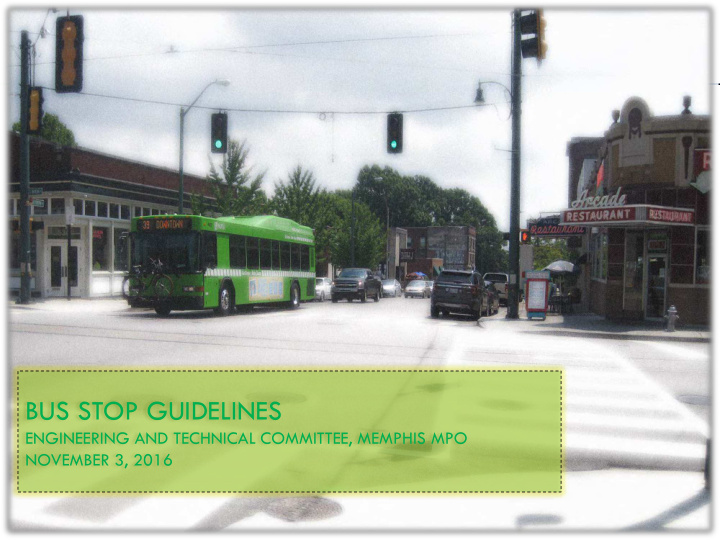



BUS STOP GUIDELINES ENGINEERING AND TECHNICAL COMMITTEE, MEMPHIS MPO NOVEMBER 3, 2016 Bus Stop Guidelines
PURPOSE & NEED • Provide relevant information in one reference guide Make it easier for planners and • engineers to incorporate bus stops in designs Assist the Greater Memphis region in • prioritizing infrastructure investment • Reduce missed opportunities for improvement Bus Stop Guidelines 2
VALUE OF BUS STOP GUIDELINES DESIGN • Transit needs are taken into account early in design of roadway projects • Investments can more easily be made by private developers • Prioritizing transit agency investments as stand-alone projects • Cost estimates for improvements Branding • Unify branding • Standardize designs Bus Stop Guidelines 3
VALUE OF BUS STOP GUIDELINES ADA/Ped/Bike • Satisfy ADA and other requirements • Improve accessibility for those with disabilities • Integrate transit with pedestrians and bicyclists Service • Improve amenities • Enhance customer experience • Attract transit ridership – bus stops are “front door” of transit system Operations • Stop spacing • Location • Length Bus Stop Guidelines 4
WORK PLAN • Memphis MPO led project Project Team – Strong collaboration with MATA • Started in April 2016 • Completion by end 2016 • Nelson\Nygaard as lead consultant – HDR – ACOT Associates Bus Stop Guidelines 5
TASKS • Document review – Complete Peer Review- Complete • • Classifying bus stops- Complete • Find Examples- Complete • Outreach – Stakeholder Meetings – Public Survey – ETC & TPB • Draft Manual- December 2016 Final Manual- Early 2017 • Bus Stop Guidelines 6
OUTLINE OF FINAL GUIDE Chapter 6 - Prioritizing Chapter 1- Introduction Chapter 4 - Bus Stop Investments Elements Purpose and Need Shelters/Benches Funding and Costs Overview of Remaining Chapters Trash Receptacles Stop Inventory Review of Existing Documents Evaluation System Signs/Maps/Info Ridership Stakeholder Input Lighting Key Corridors Chapter 2 - Stop Bike Parking and Repair Conditions Fare Machines Siting/Footprint Demographics Art Transit Service Choosing Locations Pavement Markings Far-side, Near-side, Mid-block Chapter 7 - Ongoing Protective Bollards High or Low Boarding Volume Procedures Stop Spacing Chapter 5 - Other Related Special Cases Living Document Topics Chapter 3 - Additional Info Maintenance Physical Maintenance Preliminary Design Info System Branding Coordination with Roadway and Mitigation during Construction Development Projects Role of Abutters Stops after Bus Turns Path of Travel Appendices Opportunities for Bus Lanes Conditions Transit Signal Priority Connectivity Parking Enforcement Bus Turnouts Public Involvement Curb Extensions Placemaking Superstop Locations Bus Stop Guidelines 7
QUESTIONS? Contact Information: Greg Strangeways, Nelson \ Nygaard Melissa Kim, Nelson \ Nygaard gstrangeways@nelsonnygaard.com mkim@nelsonnygaard.com 857-305-9084 857-305-90 75 MATA MPO Kwasi Agyakwa, Memphis MPO John Lancaster , MATA kwasi.agyakwa@memphistn.gov jclancaster@matatransit.com 901-576-7189 901-722-0307 Mitchell Lloyd, Memphis MPO Scarlet Ponder, MATA mitchell.lloyd@memphistn.gov sponder@matatransit.com 901-576-7146 901-722-7144 Bus Stop Guidelines 8
Recommend
More recommend